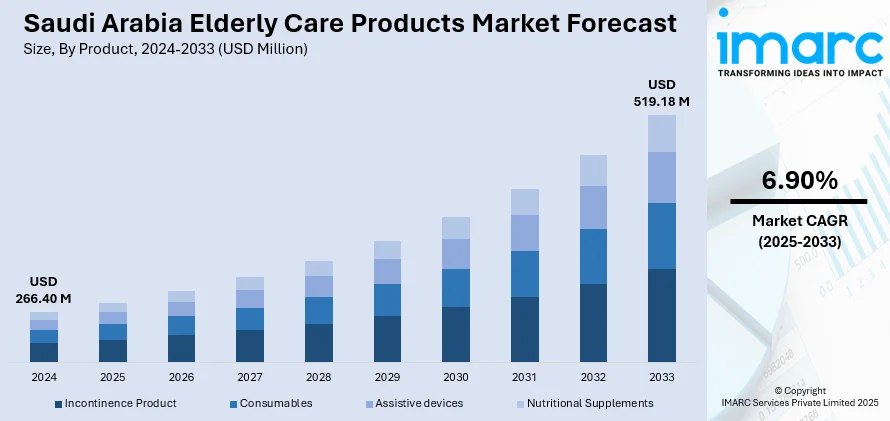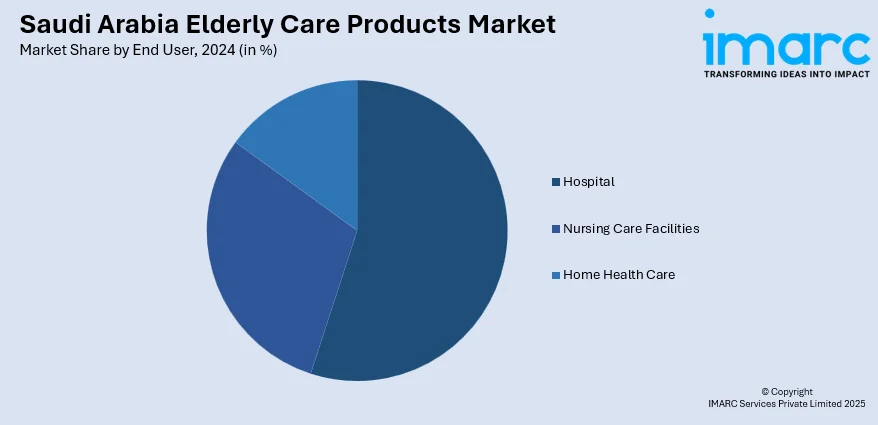
Saudi Arabia Elderly Care Products Market Size, Share, Trends and Forecast by Product, Usage, End User, and Region, 2025-2033
Saudi Arabia Elderly Care Products Market Overview:
The Saudi Arabia elderly care products market size reached USD 266.40 Million in 2024. Looking forward, IMARC Group expects the market to reach USD 519.18 Million by 2033, exhibiting a growth rate (CAGR) of 6.90% during 2025-2033. The market is driven by the growing aging population, increased prevalence of chronic diseases, and government initiatives under Vision 2030 to enhance healthcare infrastructure. Technological advancements in assistive devices and a cultural preference for home-based care further support the dynamics of the Saudi Arabia elderly care products market share.
|
Report Attribute
|
Key Statistics
|
|---|---|
|
Base Year
|
2024 |
|
Forecast Years
|
2025-2033
|
|
Historical Years
|
2019-2024
|
| Market Size in 2024 | USD 266.40 Million |
| Market Forecast in 2033 | USD 519.18 Million |
| Market Growth Rate 2025-2033 | 6.90% |
Saudi Arabia Elderly Care Products Market Trends:
Rapidly Growing Elderly Population and Increased Life Expectancy
Saudi Arabia is witnessing a demographic shift as its elderly population steadily increases due to improved healthcare services and rising life expectancy. Advances in medical care have resulted in longer lives, which naturally raise the demand for elderly care products like mobility aids, adult diapers, home monitoring systems, and assistive devices. This growth is also supported by a decline in birth rates, creating a proportionally larger elderly segment. As families increasingly rely on external care support, the market for tailored senior care products expands. Additionally, the cultural preference for home-based elder care encourages the use of specialized medical and hygiene products at home. With projections showing the elderly population growing significantly by 2050, this demographic evolution will remain a long-term driver of Saudi Arabia’s elderly care products market.

High Prevalence of Chronic Diseases Among the Elderly
Chronic diseases are increasingly common among Saudi Arabia’s aging population, with conditions like diabetes, hypertension, arthritis, and cardiovascular issues requiring constant management. This ongoing health burden creates a steady need for elderly care products such as blood pressure monitors, glucometers, orthopedic supports, and therapeutic beds, which is further driving the Saudi Arabia elderly care products market growth. Managing these conditions at home reduces the strain on hospitals and aligns with the country’s home healthcare promotion strategy. The use of remote monitoring devices, telehealth platforms, and at-home caregiving tools also helps mitigate complications. As the number of elderly citizens with comorbidities grows, there is sustained market demand for practical and affordable care solutions. These chronic disease patterns are reinforcing the importance of accessible, high-quality eldercare products across Saudi households, driving expansion of the elderly care products market throughout the country.
Technological Advancements in Elderly Care Products
Technological innovation is reshaping elderly care in Saudi Arabia, introducing advanced tools that enhance independence, comfort, and safety for seniors. Devices like smart pill dispensers, wearable health trackers, fall detection systems, and robotic aids are increasingly integrated into eldercare routines. The Saudi government’s push for digital health through initiatives such as the National E-Health Strategy encourages the adoption of tech-enabled care. These solutions support the cultural norm of aging at home while improving healthcare delivery and reducing costs. The increased use of Internet of Things (IoT), AI-powered monitoring, and mobile health applications allows caregivers to provide responsive and personalized care. As innovation continues to evolve, technological integration will be central to the growth and modernization of the Saudi Arabia elderly care products market, meeting diverse senior needs.
Saudi Arabia Elderly Care Products Market Segmentation:
IMARC Group provides an analysis of the key trends in each segment of the market, along with forecasts at the country and regional levels for 2025-2033. Our report has categorized the market based on product, usage, and end user.
Product Insights:
- Incontinence Product
- Consumables
- Assistive devices
- Nutritional Supplements
The report has provided a detailed breakup and analysis of the market based on the product. This includes incontinence product, consumables, assistive devices, and nutritional supplements.
Usage Insights:
- Home Care
- Chronic Illness Care
A detailed breakup and analysis of the market based on usage have also been provided in the report. This includes home care and chronic illness care.
End User Insights:

- Hospital
- Nursing Care Facilities
- Home Health Care
A detailed breakup and analysis of the market based on the end user have also been provided in the report. This includes hospital, nursing care facilities, and home health care.
Regional Insights:
- Northern and Central Region
- Western Region
- Eastern Region
- Southern Region
The report has also provided a comprehensive analysis of all the major regional markets, which include the Northern and Central Region, Western Region, Eastern Region, and Southern Region.
Competitive Landscape:
The market research report has also provided a comprehensive analysis of the competitive landscape. Competitive analysis such as market structure, key player positioning, top winning strategies, competitive dashboard, and company evaluation quadrant has been covered in the report. Also, detailed profiles of all major companies have been provided.
Saudi Arabia Elderly Care Products Market Report Coverage:
| Report Features | Details |
|---|---|
| Base Year of the Analysis | 2024 |
| Historical Period | 2019-2024 |
| Forecast Period | 2025-2033 |
| Units | Million USD |
| Scope of the Report |
Exploration of Historical Trends and Market Outlook, Industry Catalysts and Challenges, Segment-Wise Historical and Future Market Assessment:
|
| Products Covered | Incontinence Product, Consumables, Assistive Devices, Nutritional Supplements |
| Usages Covered | Home Care, Chronic Illness Care |
| End Users Covered | Hospital, Nursing Care Facilities, Home Health Care |
| Regions Covered | Northern and Central Region, Western Region, Eastern Region, Southern Region |
| Customization Scope | 10% Free Customization |
| Post-Sale Analyst Support | 10-12 Weeks |
| Delivery Format | PDF and Excel through Email (We can also provide the editable version of the report in PPT/Word format on special request) |
Key Questions Answered in This Report:
- How has the Saudi Arabia elderly care products market performed so far and how will it perform in the coming years?
- What is the breakup of the Saudi Arabia elderly care products market on the basis of product?
- What is the breakup of the Saudi Arabia elderly care products market on the basis of usage?
- What is the breakup of the Saudi Arabia elderly care products market on the basis of end user?
- What is the breakup of the Saudi Arabia elderly care products market on the basis of region?
- What are the various stages in the value chain of the Saudi Arabia elderly care products market?
- What are the key driving factors and challenges in the Saudi Arabia elderly care products market?
- What is the structure of the Saudi Arabia elderly care products market and who are the key players?
- What is the degree of competition in the Saudi Arabia elderly care products market?
Key Benefits for Stakeholders:
- IMARC’s industry report offers a comprehensive quantitative analysis of various market segments, historical and current market trends, market forecasts, and dynamics of the Saudi Arabia elderly care products market from 2019-2033.
- The research report provides the latest information on the market drivers, challenges, and opportunities in the Saudi Arabia elderly care products market.
- Porter's five forces analysis assist stakeholders in assessing the impact of new entrants, competitive rivalry, supplier power, buyer power, and the threat of substitution. It helps stakeholders to analyze the level of competition within the Saudi Arabia elderly care products industry and its attractiveness.
- Competitive landscape allows stakeholders to understand their competitive environment and provides an insight into the current positions of key players in the market.
Need more help?
- Speak to our experienced analysts for insights on the current market scenarios.
- Include additional segments and countries to customize the report as per your requirement.
- Gain an unparalleled competitive advantage in your domain by understanding how to utilize the report and positively impacting your operations and revenue.
- For further assistance, please connect with our analysts.
 Request Customization
Request Customization
 Speak to an Analyst
Speak to an Analyst
 Request Brochure
Request Brochure
 Inquire Before Buying
Inquire Before Buying




.webp)




.webp)












